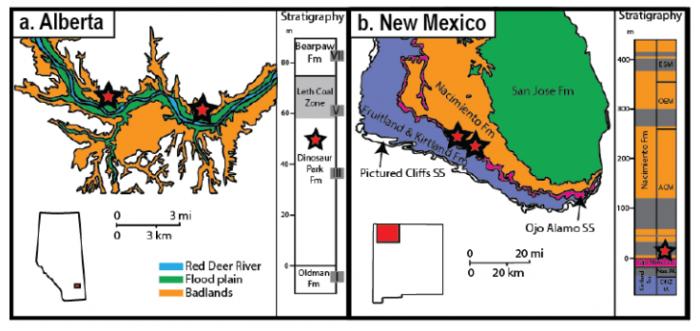
Published by Stephanie Greene
Department of Earth and Atmospheric Sciences, University of Alberta
The findings described in this article are from the Master’s thesis of Stephanie Nichols (now Stephanie Greene), and the article Introducing a new geochemical screen for identifying geologically meaningful U-Pb dates, recently published in the journal Chemical Geology (Chemical Geology 493 (2018) 1-15). That work was conducted by Stephanie Greene, Larry M. Heaman, Andrew S. DuFrane, and Philip J. Currie from the University of Alberta and Thomas Williamson from the New Mexico Museum of Natural History and Science. Stephanie Greene is now a Ph.D. student studying the evolution of the deep lithosphere as sampled by the Jericho kimberlite, with the Australian Research Council Centre of Excellence in Core to Crust Fluid Systems and Macquarie University.
Fossils provide an unparalleled window into the history of life on Earth. The way fossils change through geological strata provides information on the evolution of organisms, changes in the environment, and the occurrence of mass extinction events. But what if fossils could also provide clues about what happened in the Earth system after fossilization?
After an animal dies, if conditions are favorable and the carcass is rapidly buried, a combination of heat, pressure, and interaction with fluids will transform the chemistry of the animal’s bones and teeth. During this process – fossilization – trace elements in the fluid are incorporated into the recrystallized biomaterial. Usually, this means an increase in the concentration of rare earth elements (REE), uranium (U), and lead (Pb). The uptake of U starts the radiometric “clock.” This could theoretically provide a new tool for determining the age of sedimentary strata, which are notoriously difficult to date directly.
However, the tendency for fossils to be easily modified makes dating fossils tricky business1. A recent study2 attempts to address this problem by combining in situ trace element geochemistry and U-Pb dating of fossil teeth. This comparison allows for the identification of geochemical tracers associated with dates younger than the known depositional age of the fossils. The resulting screen provides not only a method of identifying the fossils most likely to preserve the age of fossilization, but introduces the possibility of dating volcanic episodes, mountain-building events, and perhaps even abrupt periods of climate change.

Image published with permission from Stephanie Greene
Yttrium Screen
For this exploratory study, alligatorid teeth from two 65.7-million-year-old bone beds in New Mexico, and tyrannosaur and crocodilian teeth from two 72-million-year-old bone beds in Alberta were analyzed at several points along the cross-section. Teeth were chosen because they are surrounded by enamel, a finer-grained, more compact material that may make teeth more resistant to modification by passing fluids than bone. The method of analysis used, laser ablation ion coupled plasma mass spectrometry, blasts the sample with a laser less than 0.01 mm across, providing the ability to resolve spatial variation at a very fine scale. This is important because the likelihood of post-fossilization modification makes it unlikely any sample is chemically homogenous.

Image published with permission from Stephanie Greene
Significant variations in trace elements are measured both between teeth from the same strata and across individual teeth. Greater homogeneity of trace element concentrations reflects higher diffusivity of those elements or greater concentration in the surrounding sediment. In either case, the element with the greatest inter- and intra-tooth concentration likely reflects the least or slowest change and therefore can be best used to track modification. The elements with the greatest and smoothest variation across and between teeth are yttrium (Y) and the REE. Any of these could be used to track post-fossilization modification, but Y is selected because it is present at higher concentrations than most REE and lacks redox sensitivity or fractionation effects.

Image published with permission from Stephanie Greene
In both the New Mexico and Alberta suites, the two fossils with the greatest cross-sectional Y variation were the fossils to record the age closest to the known age of their respective host strata. Among New Mexico samples, the analyses with the lowest Y concentration are at the center of a single tooth and only these analyses retain a U-Pb date consistent with the time of fossilization. The edges of this tooth show a dramatic increase in Y, approaching the composition of teeth with disturbed U-Pb dates. This is interpreted as the effect of post-fossilization modification, which increases the Y concentration and overprints the U-Pb system.
In the Alberta suite, the opposite trend is observed, and the system appears more complicated. Yttrium concentrations higher than in unfossilized teeth suggest enrichment did occur, likely during fossilization, but low concentrations of elements such as strontium suggest depletion occurred afterward. The sample retaining the oldest U-Pb date again has the largest Y range, but with the opposite profile as the most pristine New Mexico sample. The date preserved is within the uncertainty of the time of fossilization, but is most similar in age to a period of Rocky Mountain uplift. This raises the possibility that trace element modification occurring after fossilization is short-lived enough to record the precise timing of these events – and therefore a hint at their causes.
Nature of Modification Events
Most fossils analyzed record dates younger than the age of the host strata. In New Mexico, the decrease in Y range (and increase in average Y) is accompanied by a gradual transition in U-Pb isotopes from the fossilization signature to a secondary date of 25 million years ago (25 Ma). This secondary date is conspicuous because it corresponds to the end of an intense period of magmatic and volcanic activity in the region. Interaction with the trace element-enriched fluids expelled from magma bodies, or groundwater that has leached trace elements from volcanic material at the surface, may explain both the U-Pb data and the trace element enrichment recorded in these samples.
In Alberta, where fossils appear to have been depleted in trace elements after an initial enrichment during fossilization, the younger dates indicate modification around 70 Ma, 49 Ma, and 32 Ma. The latter two dates are recorded in fossils collected several kilometers apart, suggesting that these fluid flow events were not a localized phenomenon. Although it can’t be known for certain yet where these dates come from, the former two dates (70 and 49 Ma) are similar to the end of the last two pulses of Rocky Mountain formation, and the latter date (32 Ma) was a period of abrupt climate cooling, when the Antarctic ice sheet began to form3.
Rocky Mountain uplift or erosion thereafter might have influenced groundwater patterns in the Alberta basin, overprinting the fossilization U-Pb signature. Groundwater is typically fed by slightly-acidic, trace element-poor rainwater, which may be consistent with the trace element depletion observed in these fossils. However, it is not clear how abrupt global cooling could have influenced these fossils, or whether this connection might be direct or indirect.
Conclusions
Secondary dates recorded in fossils correspond with the most prominent magmatic, tectonic, and climatic regional and global events. This introduces the exciting new possibility that fossils are modified by a small number of large-scale but short-lived episodes and that these events can be reliably dated using vertebrate fossils. Although more work is required to ascertain the origin and prevalence of these overprinting events, these secondary dates appear better-preserved than the fossilization dates themselves.
This raises the possibility that every fragment of fossil, every skeleton in every museum, contains densely-packed and detailed information on the nature and timing of a myriad of geological events that post-date the life of the organism. This may prove to be an unprecedented resource for understanding ancient fluid-flow events.
References:
- Romer, R.L., 2001. Isotopically heterogeneous initial Pb and continuous 222Rn loss in fossils: the U-Pb systematics of Brachiosaurus brancai. Geochim. Cosmochim. Acta 65 (22), 4201–4213.
- Greene, S., Heaman, L.M., DuFrane, S.A., Williamson, T., Currie, P.J., 2018. Identifying geologically meaningful U-Pb dates in fossil teeth. Chem. Geol. 493, (1-15).
- Pană, D.I., van der Pluijm, B.A., 2014. Orogenic pulses in the Alberta Rocky Mountains: radiometric dating of major faults and comparison with the regional tectono-stratigraphic record. Geol. Soc. Am. Bull. 127 (3–4), 480–502.









